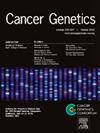细胞外囊泡对乳腺癌转移和治疗的影响:遗传学考虑
IF 2.1
4区 医学
Q4 GENETICS & HEREDITY
引用次数: 0
摘要
乳腺癌是全世界的一个重大健康问题,更好地了解乳腺癌细胞所在的微环境的细胞和分子特性至关重要。乳腺癌细胞与肿瘤微环境表现出复杂的双边相互作用,这可能有助于肿瘤的进展。这种肿瘤微环境包括大量蛋白质、蛋白聚糖、糖蛋白、信号分子、基质细胞和免疫细胞,以及细胞外囊泡。细胞外囊泡包括一系列促进细胞间通讯和信号传递的囊泡。这些细胞外囊泡的例子包括微囊泡、外泌体和凋亡小体。其他分类根据其生物起源将细胞外囊泡分为外泌体和外泌体。细胞外囊泡的内容可以是DNA、RNA、miRNA、蛋白质、聚糖和脂质。该物质可以影响肿瘤微环境和肿瘤的转移和进展。因此,这篇综述文章旨在了解肿瘤微环境中细胞外囊泡的内容以及那些促进侵袭和转移的细胞外囊泡。这些细胞外囊泡对乳腺癌治疗的意义将被讨论。最后,将讨论在这些过程中所显示的基因。本文章由计算机程序翻译,如有差异,请以英文原文为准。
The impact of extracellular vesicles on breast cancer metastasis and therapeutics: genetic considerations
Breast cancer is a significant health problem across the world, and a better understanding of the cellular and molecular properties of the microenvironment in which the breast cancer cells reside is paramount. Breast cancer cells exhibit an intricate bilateral interaction with the tumour microenvironment, which can contribute to tumour progression. This tumour microenvironment comprises a host of proteins, proteoglycans, glycoproteins, signalling molecules, stromal and immune cells, in addition to extracellular vesicles. Extracellular vesicles encompass a range of vesicles that facilitate cell-to-cell communication and signal relay. Examples of these extracellular vesicles include microvesicles, exosomes and apoptotic bodies. Other categorisations divide extracellular vesicles into exosomes and ectosomes based on their biogenesis. The content of extracellular vesicles can be DNA, RNA, miRNA, proteins, glycans and lipids. This content can affect the tumour microenvironment and tumour metastasis and progression. As such, this review article aims to understand the content of extracellular vesicles and those that promote invasion and metastasis in the context of the tumour microenvironment. The implications of these extracellular vesicles for breast cancer therapeutics will be addressed. Finally, the genes indicated in these processes will be discussed.
求助全文
通过发布文献求助,成功后即可免费获取论文全文。
去求助
来源期刊

Cancer Genetics
ONCOLOGY-GENETICS & HEREDITY
CiteScore
3.20
自引率
5.30%
发文量
167
审稿时长
27 days
期刊介绍:
The aim of Cancer Genetics is to publish high quality scientific papers on the cellular, genetic and molecular aspects of cancer, including cancer predisposition and clinical diagnostic applications. Specific areas of interest include descriptions of new chromosomal, molecular or epigenetic alterations in benign and malignant diseases; novel laboratory approaches for identification and characterization of chromosomal rearrangements or genomic alterations in cancer cells; correlation of genetic changes with pathology and clinical presentation; and the molecular genetics of cancer predisposition. To reach a basic science and clinical multidisciplinary audience, we welcome original full-length articles, reviews, meeting summaries, brief reports, and letters to the editor.
 求助内容:
求助内容: 应助结果提醒方式:
应助结果提醒方式:


